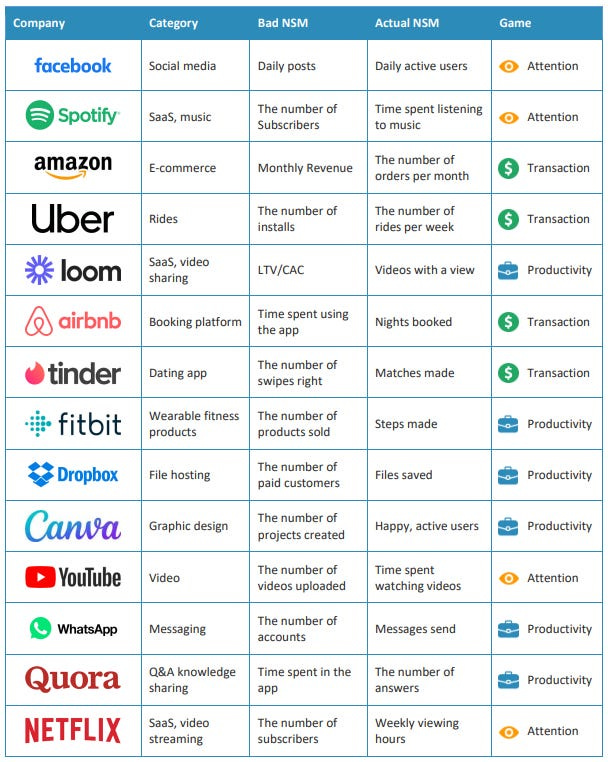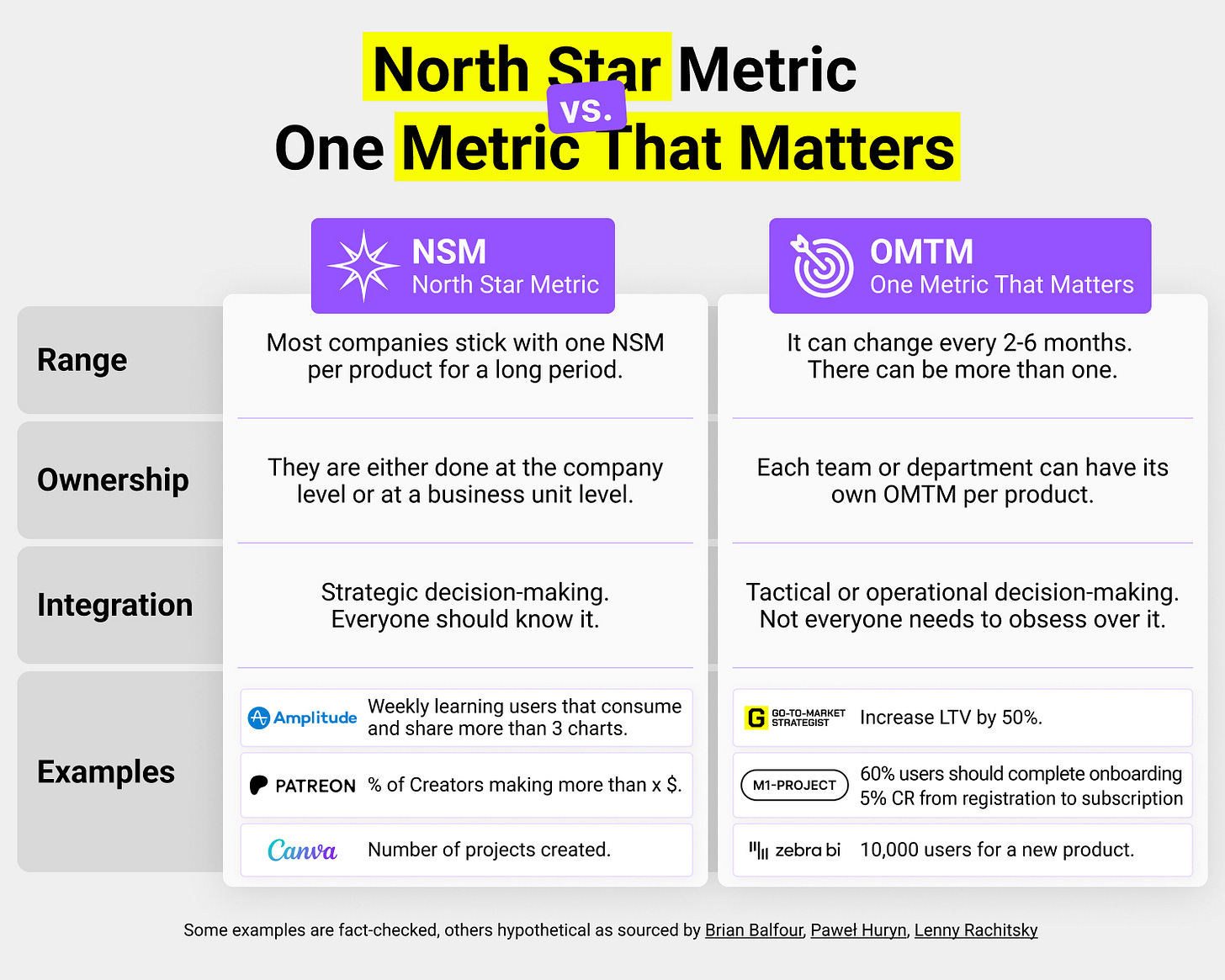Goals and Objectives are Your GTM Compass
Mission-critical metrics that should guide your GTM - Useful DIY templates inside
In this post, you will learn:
How to set the right metrics for your go-to-market strategy
How to find your North Star Metric with a new framework
How to ensure that you measure what matters
This post is sponsored by Amplitude. Apart from delivering the best analytics platform for product and marketing teams, they are also opinion leaders in this space and publish top-notch guides. Amplitude just dropped a revamped version of the North Star Playbook. Get it here.
With 2025 almost here, we are all shaping our strategies and plans for the year to come. The important plan of any plan is how to measure it. In this post, I will guide you on how to choose your top metric (your goal) and how to know that you are on the right track while getting there.
To ensure you’re highly likely to achieve the goal you’ve set and are monitoring regularly, it’s important to carefully choose which goal to pursue.
You all know that goals should be smart, right?
S - Specific
M - Measurable
A - Attainable
R - Relevant
T - Time-based
Now, here is your tactical guide on how to select mission-critical objectives and metrics that will guide your actions.
Let’s first look at my business's example to help us understand the key concepts.
Mindset: Allow yourself to think BIG 🎯
If you can dream it - you can achieve it.
The key question is: what do you want to achieve?
Oftentimes, when I talk to founders, they are shy about this.
But no need to be shy - because most people will work like a horse for 6-12 months for an “incremental improvement”. You need to think bigger.
You need something that will excite you.
That will motivate your team.
That will make you proud.
The questions that I ask myself every single day are:
“What would 10x this business”.
If I am feeling visionary, even 100x.
The key difference is that I have to believe it. Feel it.
As if it is your calling and you are on a mission.
While it is very unlikely that I am building the next Apple here, it is perfectly reasonable to challenge myself - what would have to be true that this would become a 10 million business?
That I can imagine.
And I am eager to figure it out.
It is the next frontier that I want to conquer.
This way of thinking will help me optimize my decisions in the long run - to choose “the game”, the business model that I am playing.
Yes, it can be a bit scary, some would say delusional, and really hard to tackle - but it makes ALL the difference.
Now, back to reality … What can I do NOW - this year, this quarter - to make a step towards that direction?
Most people usually underestimate what they can do in 3-5 years and overestimate what they can do in a year.
Even if your “vision” comes to life in 3-5 years instead of a year, you are still likely to achieve more than people who do not even dare to dream a little.
After you shake hands with yourself and with the team to agree on what you can do in a year - make it a written commitment.
When I was launching GTM Strategist, it was mission-critical to sell 2000 copies in the first month.
How did I get this number?
I took some historical data from colleagues on how many copies they had to see at launch to make an Amazon best-seller. Then I rounded up the number “just to be safe” if some whale was launching on the same day.
From then on - we were “mission critical 🎯 = selling 2000 copies”
It was a key piece of alignment that we needed for the launch.
Everyone could use this prism to make the right shots.
If you operate like this, it is more a question of WHEN than IF you will do it.
It is tough to beat a person on a mission.
You will find ways to make it happen.
Now, a super honest conversation: what is the worst thing that could happen if I failed this?
I would still sell like 500 units because I will do the work …
…well that is 5X the case if I would set myself a modest vanilla goal such as selling 100 copies.
That is too easy. And easy is the enemy of great.
The next question is: how to get there?
For me, 1-page marketing plan often comes to the rescue. Here is how I thought about the business I am working hard to build last year:
As 🎯mission critical = sell 2000 copies objective was done, I did not want to leave the team in a vacuum. We needed a “bigger purpose” - something that would capture the essence of value that our ecosystem is providing.
And I set up my first North Star Metric (more info later) that I keep on using today:
BIG vision: Help 10,000 a year to cross the chasm with GTM Strategist method.
This was probably one of the best decisions I made last year so the team did not end up in a vacuum and existential crisis of the absence of an objective after we achieved our mission critical. We need to know immediately what our next hill to conquer is.
More importantly, the buy-in from the team was even stronger.
How could it not be - to sell X amount of something secured our lifeline, but now we are on a mission to help, to make an impact. For most, that is a better motivation.
Now - YOU time.
How can you use this powerful alignment mechanism in your business?
Bottom-line metrics vs. North Star Metric
When shaping a go-to-market strategy, you need to understand the distinction between bottom-line metrics and the North Star Metric (NSM). As Sean Ellis wrote, the North Star Metric is the single metric that best captures the core value that your product delivers to customers. When you optimize your efforts to grow your NSM, it drives sustainable growth across your entire customer base.
Bottom-line metrics focus on financial outcomes that demonstrate your company’s overall health and profitability—think revenue, profit margins, or cash flow. These metrics provide a snapshot of whether your business is thriving, making them essential for financial planning, for investors, board members, and other stakeholders. However, while crucial, bottom-line metrics often reflect past performance rather than driving future growth.
In contrast, the North Star Metric serves as a unifying, forward-looking guide. It represents the one metric that best captures the core value a company delivers to its customers.
For example, a subscription-based service might focus on "weekly active users” because someone who regularly uses the service signals customer satisfaction and retention.
Another benefit of the NSM is that it aligns cross-functional teams, helping them focus on activities that directly impact sustainable growth. Marketing, sales, product, customer service, and other teams should think about how they can contribute to improving the NSM with their actions. In the case of “weekly active users”, marketing by communicating the value to the right users, the product team by improving the product, and so on.
The interplay between the bottom-line metrics and NSM is crucial for success. Bottom-line metrics measure the outcome of actions driven by the NSM. By focusing on the North Star Metric, teams ensure their efforts create meaningful value for customers, which ultimately fuels the bottom line.
In short, you need to make sure that you also monetize and capture some of the value you deliver to your customers - so that your NSM is correlated with the bottom-line metrics such as revenue and profit.
Which game are you playing?
Amplitude researched more than 11,000 companies and 3 trillion user actions. They have learned that all digital products are playing one of three possible games:
The Attention Game: How much of your customers’ time can you capture in your product?
The Transaction Game: How many commercial transactions does your user make on your platform?
The Productivity Game: How many high-value digital tasks can your customer perform in your product?
Here are some examples of NSM and the “games” from well-known tech companies, as prepared by Paweł Huryn from The Product Compass:
How to define your North Star Metric?
Amplitude just published a revamped version of their North Star Playbook with more than 60 pages of actionable advice from top experts.
I especially like this North Star statement exercise that will guide you toward defining the NSM that will work for you:

If you want to dive deeper, here is a guide to discovering your product’s North Star by Amplitude: https://amplitude.com/resources/north-star-playbook
North Star Metric vs. One Metric That Matters
When setting on a go-to-market journey, finding the perfect North Star Metric (NSM) can seem like a good-to-do, not mission-critical thing. And I get it - if you don’t even know if you have a business, go all-in on the metric that will “keep the lights on”- a short-term One Metric That Matters (OMTM) and worry about your North Star Metric later.
OMTM keeps your business operational and focused during the critical early stages, bridging the gap until you can establish a more comprehensive North Star Metric. It's about strategic adaptability and laser-focused execution when resources are limited.
By examining case studies from companies like Amplitude, Canva, Patreon, and smaller ventures like M1 Project, Zebra BI, and Growth Lab, I've concluded that while a North Star Metric is an excellent strategic guide post-product-market fit, the OMTM is crucial for survival and initial momentum.
To measure North Star Metric correctly, you must also have a sound analytics system. In my case, the NSM of “getting 10,000 businesses across the chasm” could not be accurately defined before I started to sell the digital products through my platform and collected feedback from readers - did they really implement this?
In all honesty, I cannot claim that I helped someone “to cross the chasm and reach early majority” if they liked my LinkedIn status 🙈- my team would laugh if I pitched this proxy.
Now go, go, go and implement this!
What is your mission-critical objective for 2025, and what could be your North Star Metric that measures the value created in your ecosystem? Download Amplitude’s North Star Metric report if you need more insights on defining NSM 🌠 and remember to write your objectives down.
According to bro science on LinkedIn, written objectives are 42% more likely to be achieved 🤠
But seriously, do it because it is good for you and your team.
📘 New to GTM? Learn fundamentals. Get my best-selling GTM Strategist book that helped 9,500+ companies to go to market with confidence - frameworks and online course included.
✅ Need ready-to-use GTM assets and AI prompts? Get the 100-Step GTM Checklist with proven website templates, sales decks, landing pages, outbound sequences, LinkedIn post frameworks, email sequences, and 20+ workshops you can immediately run with your team.
🏅 Are you in charge of GTM and responsible for leading others? Grab the GTM Masterclass (6 hours of training, end-to-end GTM explained on examples, guided workshops) to get your team up and running in no time.
🤝 Want to work together? ⏩ Check out the options and let me know how we can join forces.







